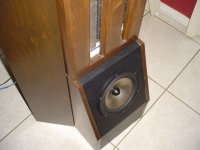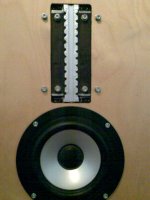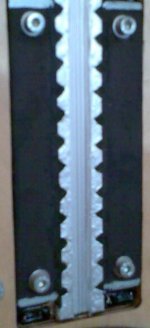Beyer ribbon Microme have a special corrugated ribbon:
The picture is from this thread: Beyer M160 ribbon mic
The central part is rigidified whereas the sides act like a suspension. Has anyone tried such corrugation for a speaker?
Bruno
An externally hosted image should be here but it was not working when we last tested it.
The picture is from this thread: Beyer M160 ribbon mic
The central part is rigidified whereas the sides act like a suspension. Has anyone tried such corrugation for a speaker?
Bruno
Corrugation hurts the midrange IMO, so i have created the suspension at the ends for tensioning and low freq response and left the middle smooth , best compromise so far .
Corrugating the tweeter does work .....
Corrugating the tweeter does work .....
Attachments
Last edited:
I did make a multi striped ribbon shaped like that, But I never got to test it,many many years ago.
As of last year I still had it,But now I can't find it as I was going to post a picture of it to show my etching technique on another thread. 🙁
I used copper foil etched and then sandwiched in between two layers of .25mil mylar with a very very thin layer of rubber cement.
I was exteremly light and the long folds gave it alot of rigidity.
And it did not readily bend easily.
I was messing around with ribbon designs from 1992 to 1998.
jer
As of last year I still had it,But now I can't find it as I was going to post a picture of it to show my etching technique on another thread. 🙁
I used copper foil etched and then sandwiched in between two layers of .25mil mylar with a very very thin layer of rubber cement.
I was exteremly light and the long folds gave it alot of rigidity.
And it did not readily bend easily.
I was messing around with ribbon designs from 1992 to 1998.
jer
Last edited:
Corrugation hurts the midrange IMO, so i have created the suspension at the ends for tensioning and low freq response and left the middle smooth , best compromise so far .
Corrugating the tweeter does work .....
I came accross this patent:
Ribbon Loudspeaker Having Corregated Ribbon For Reducing Distortion
In this patent, the corrugations at the two ends are 5 times larger than in the middle.The goal is to reduce the "snaking" of the ribbon - I am not sure what that means.
Hi,
i have shown this one before, but it does not move
pistonic, it bends preferably around the vertical
axis ...
Found: http://www.diyaudio.com/forums/planars-exotics/123841-esl-ribbon-6.html#post1533609
Corrugation hurts the midrange IMO, so i have created the suspension at the ends for tensioning and low freq response and left the middle smooth , best compromise so far .
Corrugating the tweeter does work .....
The speaker shown in the pictures looks interesting. Is there more information/details available somewhere?
Thanks,
Bruno
I came accross this patent:
Ribbon Loudspeaker Having Corregated Ribbon For Reducing Distortion
In this patent, the corrugations at the two ends are 5 times larger than in the middle.The goal is to reduce the "snaking" of the ribbon - I am not sure what that means.
The ribbon tends to bend like a snake after full corrugation making it difficult to tension and kept straight. If you want ( and you want ) tight magnetic gaps he is using the bigger folds to get the ribbon tensioned straight without "S" bends (snaking).....
regards,
Hi,
i have shown this one before, but it does not move
pistonic, it bends preferably around the vertical
axis ...
i know old post 🙂 but that looks the same method as ABJensen did with paper. i was looking for that post, since i tried one few years back, and it had some benefits 🙂
Ive actually built many ribbon design using similar concept (rigid structured ribbon. Some with compliant ends), from small ones used above 3 kHz to larger ones used to 100 hz and even below.
When all is balanced just so there can be some benefit in some areas of the freq response. The rigid structure does some good at controlling some resonances BUT it also introduces others and in the end you tend to get a less flat freq response BUT it can handle lower frequency info much better. its all a balancing act of pluses and minuses that I suspect they have worked to some effect to get a sound they like??
Eventually after years of development work I patented a ribbon design that is a refinement of the "rigid ribbon" concept in that the rigidity and damping are actually tuneable . The goal was to be able to utilize the lower frequency standing wave control of a more rigid ribbon while keeping the smoother mid frequency operation of the more flexible types. The design allowed a smallish 6 inch long ribbon to be used effectively to 500 hz.
When all is balanced just so there can be some benefit in some areas of the freq response. The rigid structure does some good at controlling some resonances BUT it also introduces others and in the end you tend to get a less flat freq response BUT it can handle lower frequency info much better. its all a balancing act of pluses and minuses that I suspect they have worked to some effect to get a sound they like??
Eventually after years of development work I patented a ribbon design that is a refinement of the "rigid ribbon" concept in that the rigidity and damping are actually tuneable . The goal was to be able to utilize the lower frequency standing wave control of a more rigid ribbon while keeping the smoother mid frequency operation of the more flexible types. The design allowed a smallish 6 inch long ribbon to be used effectively to 500 hz.
Ive actually built many ribbon design using similar concept (rigid structured ribbon. Some with compliant ends), from small ones used above 3 kHz to larger ones used to 100 hz and even below.
When all is balanced just so there can be some benefit in some areas of the freq response. The rigid structure does some good at controlling some resonances BUT it also introduces others and in the end you tend to get a less flat freq response BUT it can handle lower frequency info much better. its all a balancing act of pluses and minuses that I suspect they have worked to some effect to get a sound they like??
Eventually after years of development work I patented a ribbon design that is a refinement of the "rigid ribbon" concept in that the rigidity and damping are actually tuneable . The goal was to be able to utilize the lower frequency standing wave control of a more rigid ribbon while keeping the smoother mid frequency operation of the more flexible types. The design allowed a smallish 6 inch long ribbon to be used effectively to 500 hz.
Yeah funny i played with the vertical corrugation yesterday. and yes low end much better. but as you said 🙂 you will have other problems arise 🙂 so im back to planar again 🙂 realy wonder about your patent 🙂 but that.... might be a secret for a few years i guess 🙂
You don't have to wait quite that long...
US9668057B1 - Ribbon transducer - Google Patents
US9668057B1 - Ribbon transducer - Google Patents
Attachments
Yeah funny i played with the vertical corrugation yesterday. and yes low end much better. but as you said 🙂 you will have other problems arise 🙂 so im back to planar again 🙂 realy wonder about your patent 🙂 but that.... might be a secret for a few years i guess 🙂
Oh cool. Yea it does have some nice qualities in the bass AND noteworthy is the fact that Apogee,s bass diaphragm is basically done this way. Yes its a planer BUT I have built a number of variations on that theme in planers and all benefited by it once you got the right balance of all the particulars.
BTW thanks Bolserst for the post !
- Status
- Not open for further replies.
- Home
- Loudspeakers
- Planars & Exotics
- Pistonic corrugation



